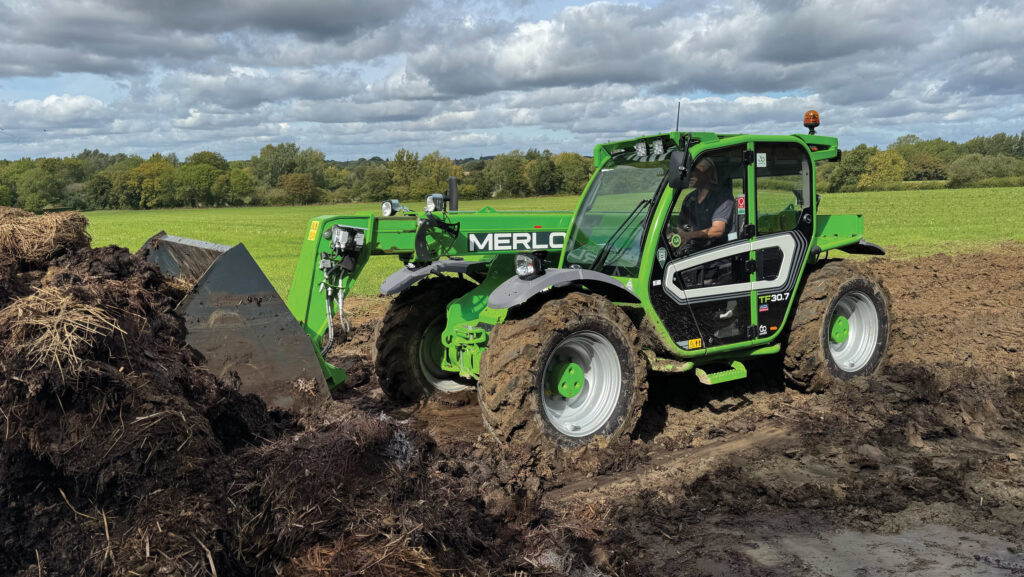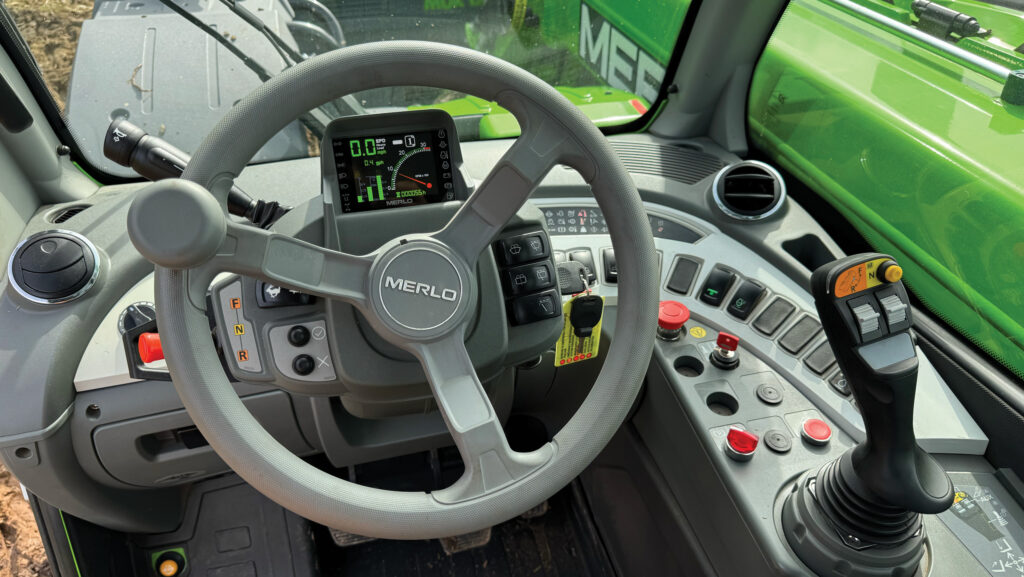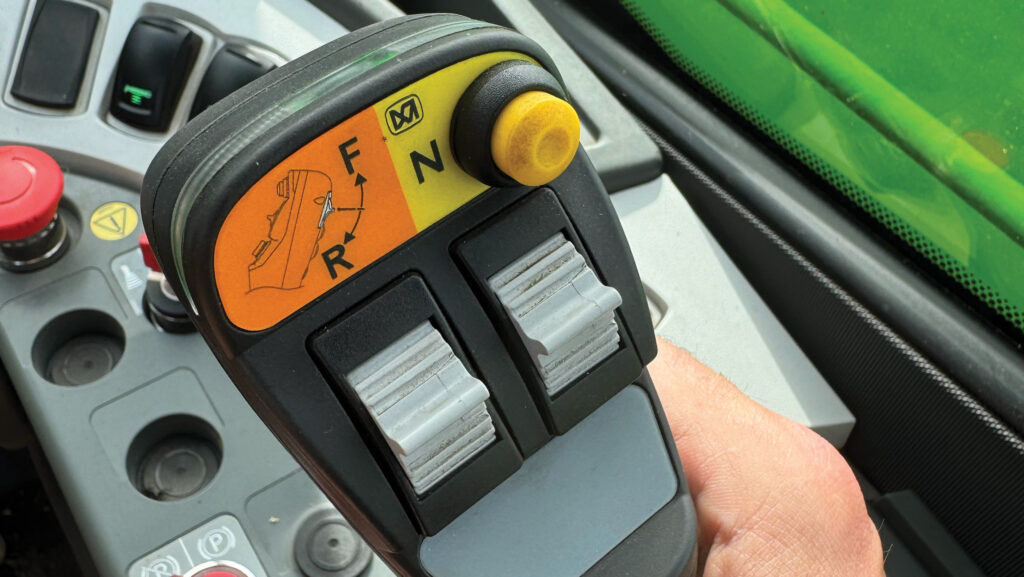On test: Merlo TF30.7 – small frame, pokey hydraulics
 © MAG/Oliver Mark
© MAG/Oliver Mark A surge of farmers pining for more lifting and loading capacity without compromising on size has spawned a slew of pint-sized telehandlers.
Merlo’s TF30.7 is one of the latest to join the fray, with its satisfyingly square 2m high by 2m wide profile allowing it to slink down skinny passages and under low-slung girders.
See also: On test: Stacks of power in diddy JCB 530-60
Its introduction fills a fissure in the lower reaches of the firm’s line-up that has remained since the popular P32.6 succumbed to emissions regulations back in 2017.
That machine’s compact design proved a hit with livestock farms and the newcomer could well attract the same cult following given its broadly similar dimensions, together with a bigger and altogether nicer cab, and more generous specification.
However, it is certainly no carbon copy.
While it retains the seemingly sacrosanct 2m width, it’s 28cm longer – an extended wheelbase stretching it to 4.51m – 450kg heavier, at 6.6t, and sits 65mm closer to the ground.
These alterations combined allow it to reach 20cm further with the boom fully extended, and 70cm higher – albeit only to 6.7m, rather than the “7” that the fanciful model numbering would have you believe.
True lift capacity is reflected in the nomenclature, though: a 3t rating, down 200kg on its forebear.
The other notable change is spec. The 30.7 is a TF (TurboFarmer), gaining it a rear pick-up hitch and diff-lock as standard.
By comparison, the 32.6 was only offered as a stripped back “P” derivative designed with the construction sector in mind.
Pushing power
Like most of its peers, Merlo calls on a hotchpotch of engine providers to power its range of machines.
The popular 27.6 runs a well-respected 75hp Rehlko (Kohler), Perkins provides 115hp and 136hp units for the mid-rangers, Deutz gets the nod on pokier CV-Tronics, and there are FPTs in the big construction kit.

Cab space is generous; the size of the dash display less so © MAG/Oliver Mark
For the 30.7, this duty has been handed to another Deutz four-cylinder – albeit a diddy one.
It musters 101hp and 420Nm from its modest 2.9-litre capacity, putting it 14hp shy of the next smallest TurboFarmer – the TF33.7 (6.6m/3.3t).
It’s fine, and very fuel efficient, for general yard labour, but we found it a little easy to stall in the depths of a muckheap.
In contrast, JCB’s 530-60 Agri Super runs a big 4.8-litre that puts out 130hp and 550Nm.
Considering the loader’s dinky proportions, you’d expect the engine bay to be rammed like the suitcase of an Ibiza-bound 20-something.
Not so. But the locations of some components have been sacrificed to accommodate emissions paraphernalia: the fuel filters fitted inside the front wheel and the battery slightly awkwardly inbound of the nearside rear.
The setup doesn’t allow for a reversing fan option, either.
And although most of the service essentials are obvious, greenhorns could come a cropper when topping up the hydrostatic oil reservoir or coolant tank. The two are uncannily similar.
Fuel provision is respectable though. The front-mounted 90-litre tank might not be cavernous, but it makes a mockery of the 66 litres offered by the aforementioned JCB.
New engine-related features include an auto revving function designed to improve the sprightliness of the already rapid hydraulics.
When engaged, this ups crankshaft speed in response to joystick movements, the rpm limit for which is set on a twizzly dial.
There’s certainly no need to deploy it on light-duty work – operators already need a delicate hand to deliver smooth boom movements.
However, it does save working the inching pedal and revving the throttle simultaneously to get things moving in haste.
When auto rev isn’t engaged, the same dial can be used as a hand throttle, leaving the pedal to control forward speed when running a bucket brush or auger.
Time-proven transmission
Nothing radical to report on the transmission front, with Merlo staying true to its roots in fitting a two-range hydrostatic setup that offers top speeds of 15kph and 40kph.
With drivetrain and engine working in harmony, it’s dead quiet – bar the drone from the optional (£1,800) but efficient air conditioning system.
Unusually, this bolts to the back of the roof and can be retrofitted post-sale if one comes to regret initial penny pinching.
Other than the static range change and footwell diff-lock button, which yokes front and rear wheels to maintain traction on a muck heap or silage pit, there’s very little to know about driving it.

Plenty of under-bonnet space for Deutz’s 2.9-litre four-cylinder © MAG/Oliver Mark
The right pedal deals with going and stopping, and there’s seldom reason to dabble with the brakes given the hydrostat’s ability to hold the handler on a 60deg slope in gear without rolling so says Merlo.
Keen beans can fiddle with the two “eco power drive” (EPD) modes, one of which strangles performance to save fuel on light-duty work.
It’ll also tamper with the transmission ratios once it’s wound up to top speed to tame engine revs to 1,400rpm.
Allied to this is a secret cruise control, engaged by holding the shuttle lever forwards for a few seconds once at the target speed.
The only real downside in the transmission department – towing limitations aside – is the slightly irritating park brake, which is akin to having a yappy dog for company.
It’s electric but otherwise unsophisticated: it won’t engage or disengage automatically and howls incessantly should it be locked on when not in neutral and, vice versa, when a direction is selected and it isn’t released.
Small machine, big cab
Three cabs are on offer, the choice of which will be determined by shed roof height and budget.
The standard setup, seen here, leaves the cab lid 2.12m from terra firma.
If that’s too tall, there’s a low cab “L” derivative that shaves 14cm off total height in exchange for 3cm of ground clearance (27cm).
Pushing the boat out in the name of comfort gets you 11cm of cab suspension travel, at the expense of overall height – up 9cm on standard. CS spec costs about £5,000.
This latest machine also sees the partial return of Merlo’s “ring of steel” concept – that being a tubular steel belt with structural and protective benefits.
This runs around the rear, adding weight to offset the extra reach.
Cab access is via the firm’s two-piece glass door, attractive mainly for its ability to be pinned fully back during in ‘n’ out feeding work.
And interior space is surprisingly generous given the machine’s otherwise dainty proportions, helped in part by offsetting the boom by circa 15cm.
Headroom is the limitation, and lankier operators might find their Brylcreemed quiff brushes the ceiling.
But there’s plenty of storage space for remedial hair products in twin glove boxes – fore of the left leg and in the rear corner of the cab.
Views outwards are a mixed bag. They’re good forwards and to the side, thanks to the low boom pivot and fully glazed stable door.
Judging the position of the offside rear wheel is altogether more challenging, with the exhaust cowling blocking any points of reference.
Nor is it much better rearwards, with line of sight severely restricted by that barnet-wrecking low roof, even lower window, and protruding air conditioning unit.
Protection of roof glass is provided by cross-hatched 10mm thick steel plate.
Crucial, obviously, but its front finishes at the top of the lift arc, which is slightly annoying when loading a muckspreader or grain trailer.
It can be unbolted to give the windows a good clean, though the front one mightn’t need much attention if you’re flummoxed when it comes to stopping the wiper.
Much like the cruise control function, it’s a clandestine affair. Rather than a simple switch or lever, it can only be turned off by holding the rocker for four seconds.
Presumably this is giving someone at Merlo HQ a good laugh.
Simple controls
Wipers aside, there’s something satisfyingly simple about the machine’s controls, with most of the rocker switches lined along a “banana board” that sweeps from steering wheel to joystick.
These include the boom suspension and transmission/engine settings, all of which are well labelled and eminently decipherable.
The joystick works nicely too. A particular highlight is the hand-detecting heat sensors buried under the plastic.
These work no matter your grasp, and mean there’s no need to resort to an elastic band on a moving trigger.

Hydraulics are unlocked when joystick sensors detect the operator’s hand © MAG/Oliver Mark
It houses forward/reverse shuttle controls on its spine as an alternative to the old-school left-hand shuttle stick; the latter’s return-to-centre operation meaning drivers can flit between the two as they please.
Both means of control are functional if not perfect: the stick less positive than you’d get in a JCB Loadall, the F/R rocker positioned a little high on the joystick for this writer’s liking – albeit a trivial gripe in the scheme of things.
The puny digital display is potentially more of an issue.
No qualms with the information it shows – fuel level, transmission range et al – but reading the small print will be a test for the visually impaired.
Pushing power
The engine may have given up several times deep in the muckheap, but the 100 litre/min hydraulics offered serious boom-pushing power and almost always had more to give.
Given the heavy workload we subjected it to – brimming the 1.9cu m bucket with dense, well-rotted muck – the overload limiter was conspicuous only by its absence.
One assumes the generous wheelbase played its part in this good behaviour. But it will have been aided by the fitment of Merlo-branded attachments.
These come with identification discs that register with a detector on the telehandler’s carriage.
Behind the scenes, the computer then tweaks the load parameters to match, thus providing a little more tear-out force and lift capacity before the limit is exceeded.
There is the option of something fancier than the traffic light-style load display system on the cab pillar.
This comes by way of a 10in screen that allows owners to store hydraulic flow settings, view visual loads charts – including remaining capacity – and complete a dry lift at a particular height and reach to ascertain limits.
It also brings an on-board weighing system to the party.
Other features worth a mention are the two auxiliary hydraulic services, dual-line brakes and pick-up hitch as standard at the back.
The latter is mounted relatively low, which might be a problem with some trailers.
And boom suspension is an optional extra, to the tune of £1,800.
Farmers Weekly verdict
The 27.6 remains Merlo’s most popular machine in the smaller telehandler classes, but the 30.7 betters it for power, lift and reach.
And there’s lots to like about this nimble newcomer: punchy hydraulics hit the spot, the controls are simple and the cab comfortable.
The 2.9-litre engine has its limitations, and the rearward visibility is far from ideal, but if you can get over those shortcomings then it could be a goer.
Likes and gripes
Likes
- Simple controls
- Well organised and spacious cab
- Powerful hydraulics
- Diff lock
Gripes
- Limited rearwards visibility
- Lack of headroom
- Engine a little easy to stall
- No reversing fan option
Merlo TF30.7
- Engine 2.9-litre, four-cylinder Deutz
- Max power 101hp
- Max torque 420Nm
- Transmission Two-range hydrostatic
- Top speed 40kph
- Operating weight 6,450kg
- Hydraulics 100 litre/min, load sensing and flow sharing
- Max lift capacity 3,000kg
- Max lift height 6.7m
- Max reach 3.8m
- Ground clearance 300mm
- List price £95,212

